As search engine optimization continues to evolve, keyword clustering has become a crucial technique for improving website rankings and driving targeted traffic. By grouping similar keywords together, websites can effectively target a wider range of search queries and increase their visibility to potential customers. However, simply brainstorming keywords on your own may not be enough to stay ahead in the competitive online space. In this chapter, we will explore advanced techniques for keyword collection, specifically utilizing Google Keyword Planner. This tool not only helps expand your keyword list, but also provides valuable insights into their search volume, competition, and cost-per-click data. Let’s dive into how Google Keyword Planner can take your keyword clustering to the next level.

In the world of SEO, keyword research is a crucial step in driving traffic to your website or blog. While most people focus on targeting high-volume, competitive keywords, there is also value in targeting long-tail keywords. These are longer, more specific search terms that may have lower search volume but can be highly relevant to your target audience.
Why Target Long-Tail Keywords?
Targeting long-tail keywords can have several advantages:
- Less competition: Long-tail keywords are typically less competitive compared to broader, high-volume keywords. This means that it may be easier to rank for these keywords and attract relevant traffic to your website.
- Higher conversion rates: Long-tail keywords are usually more specific and reflect the user’s search intent. This means that if your content matches their search intent, they are more likely to convert into a customer or take action on your website.
- More targeted traffic: By targeting long-tail keywords, you are attracting a more targeted audience that is actively searching for a specific solution or answer. This can lead to higher engagement and a better user experience on your website.
The best way to collect long-tail keywords is to utilitize Google Keyword Planner.
One of the most important steps in conducting keyword research is collecting a comprehensive list of relevant keywords. This not only helps to identify the best keywords to target but also ensures that you are not missing out on any potential opportunities. In this chapter, we will explore advanced techniques for keyword collection, specifically using Google Keyword Planner.
Step 1: Prepare Your Basic Keyword List
Before you can start using Google Keyword Planner, you need to have a list of keywords to work with. This list should include a mix of head terms and long-tail keywords. Head terms are generally shorter, more generic keywords, while long-tail keywords are longer and more specific phrases. A mix of both types of keywords will ensure that you are targeting both high-volume and low-volume searches.
You can collect the basic keywords from:
- your SEM report
- “Top keywords” report of your competitors from keyword analysis tools like Ahrefs
Step 2: Log in to Google Keyword Planner
To use Google Keyword Planner, you will need to have a Google Ads account. If you do not have an account, you can sign up for free. Once you have an account, log in to Google Keyword Planner.
Step 3: Select “Discover New Keywords”
In the Google Keyword Planner, select “Discover New Keywords” under the “Tools” tab.
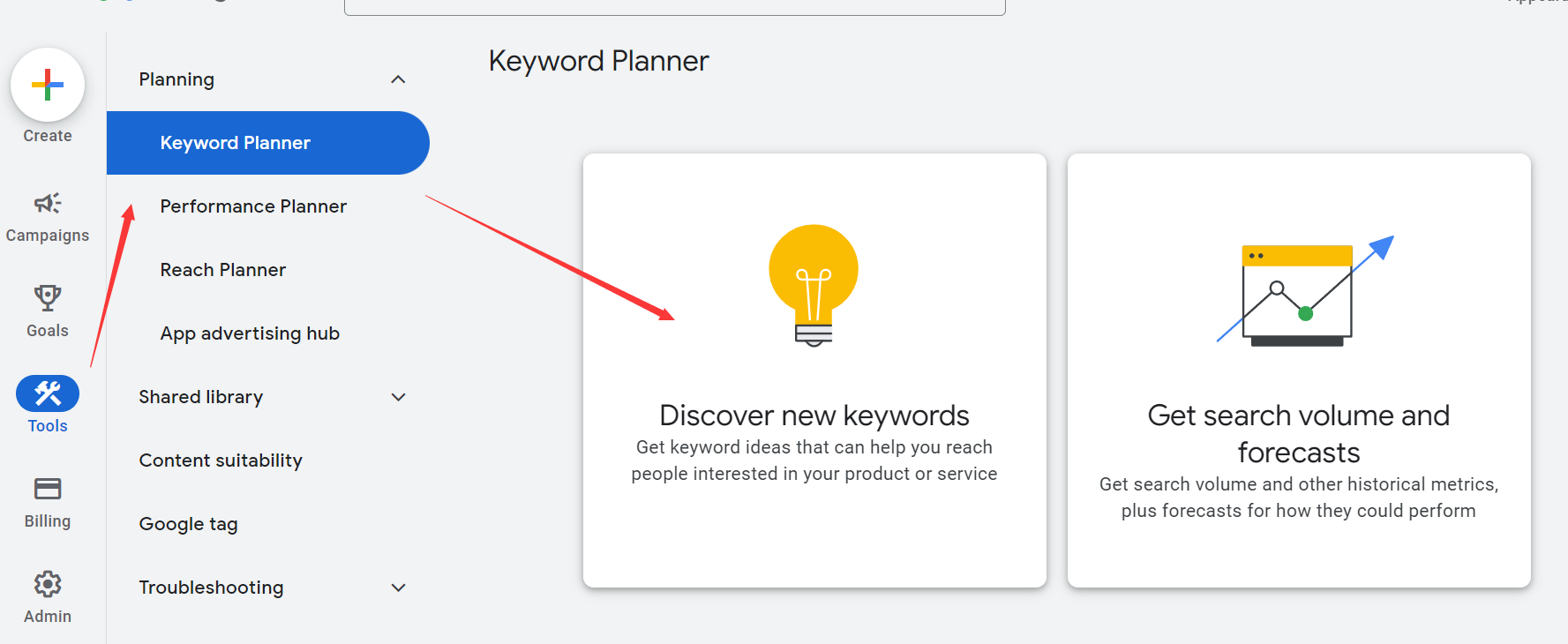
Step 4: Enter Your Keyword List
Enter your keyword list into the search field. You can enter up to 10 keywords at a time. It is recommended to start with a smaller list and then add more keywords as needed.
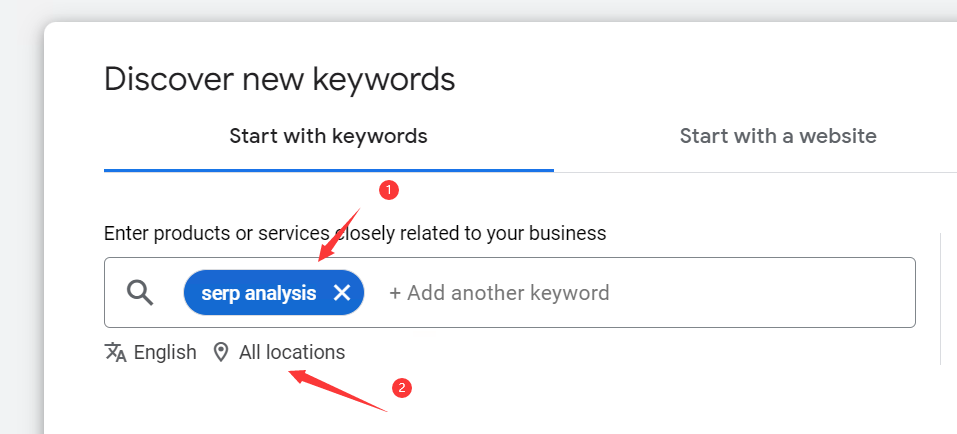
It is recommended to use “All locations” for SEO purpose.
Step 5: View Results
After clicking “Get Results,” you will see a list of keyword ideas. These ideas will include average monthly searches, competition, and suggested bid. You can also use filters to refine your results and find high-value keywords.
Step 6: Download Your Keyword List
Once you have a list of keywords that you want to target, you can download the list as a .csv file. This will allow you to easily import the keywords into other keyword research tools or your own keyword database.
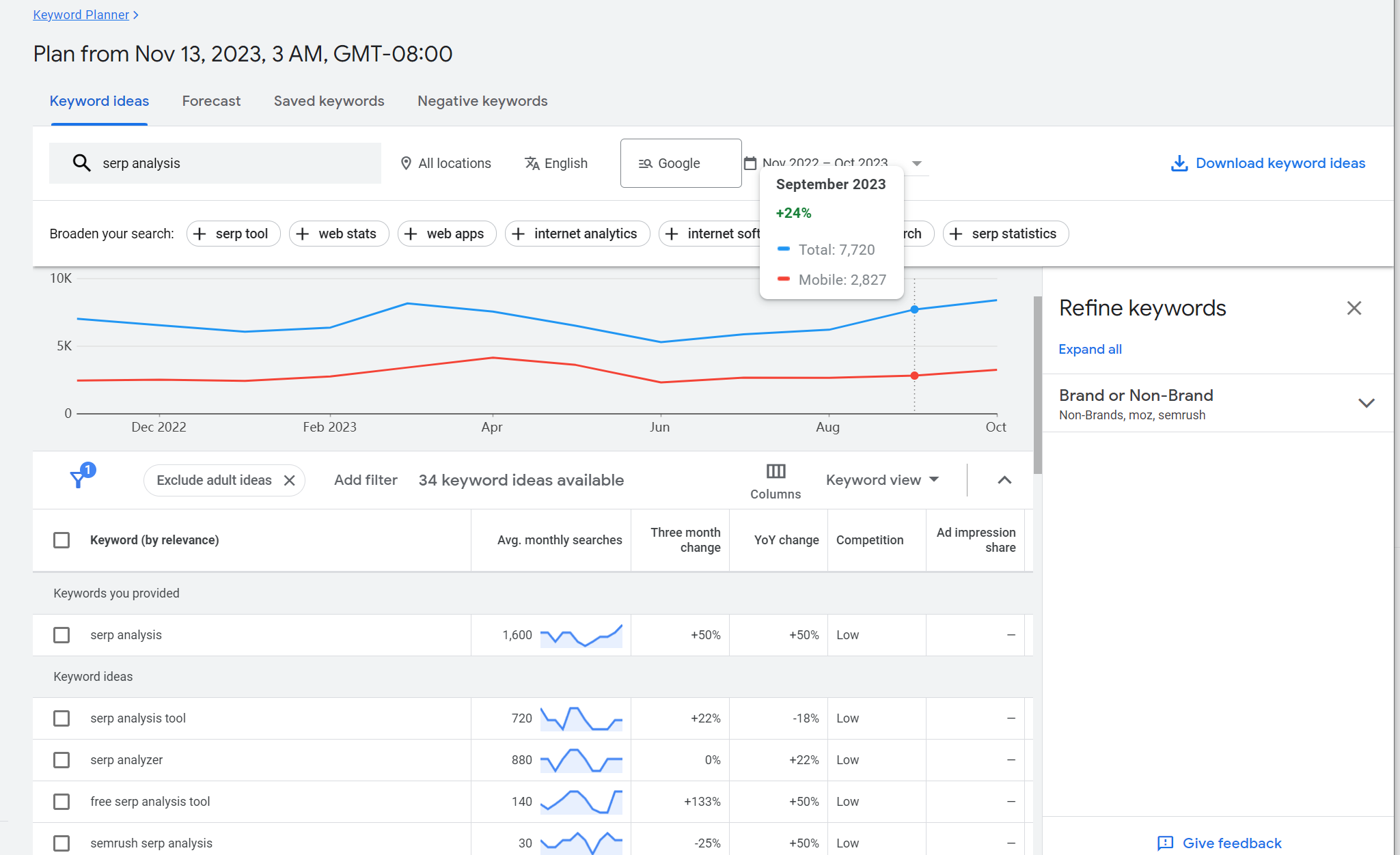
By utilizing Google Keyword Planner, you can quickly and efficiently expand your keyword list. Not only does this help to identify keyword opportunities, but it also ensures that you are not missing out on any potential search queries.
In the later charpters, we will cluster keywords basic on these expanded keywords.
Grouping or clustering keywords is important because it helps to organize and structure large sets of data or information. By grouping similar keywords together, it becomes easier to analyze and extract meaningful insights from the data.
Here are some specific reasons why grouping or clustering keywords:
1. You can save time by writing one article for keywords that are similar or equal. For instance, “serp analysis” and “analysis serp” are the same, while “serp analysis” and “serp analysis meaning” are very similar. This will significantly reduce your workload.
2. Keyword clustering allows you to separate similar keywords targeting different topics. For example, “keyword clustering” focuses on explaining the definition and principle, while “keyword clustering tool” introduces various tools for performing keyword clustering operations.
3. Grouping or clustering keywords helps in organizing and structuring your SEO strategy. By categorizing keywords into specific groups, you can easily prioritize and focus on optimizing certain topics or themes, making your overall SEO efforts more efficient and effective.
Since keyword clustering has so many benefits, what methods or tools do we have that can help us? Let’s learn about the various methods and tools available for effective keyword clustering in the upcoming chapters.
Clustering with overlapping components
The core of strategic keyword clustering revolves around grouping keywords by overlapping components. The goal is to identify keywords that share as many common elements as possible. For example : “serp analysis” and “analysis serp” are 100% overlapping. By identifying and grouping keywords with overlapping components, you can create more effective marketing strategies.
This method is very simple, and there are many free or charged solutions on the market:
1. https://keywordclustering.zenbrief.com/
It is an online solution, you can input hundreds of keywords in the input dialog and get the result in a few minutes.
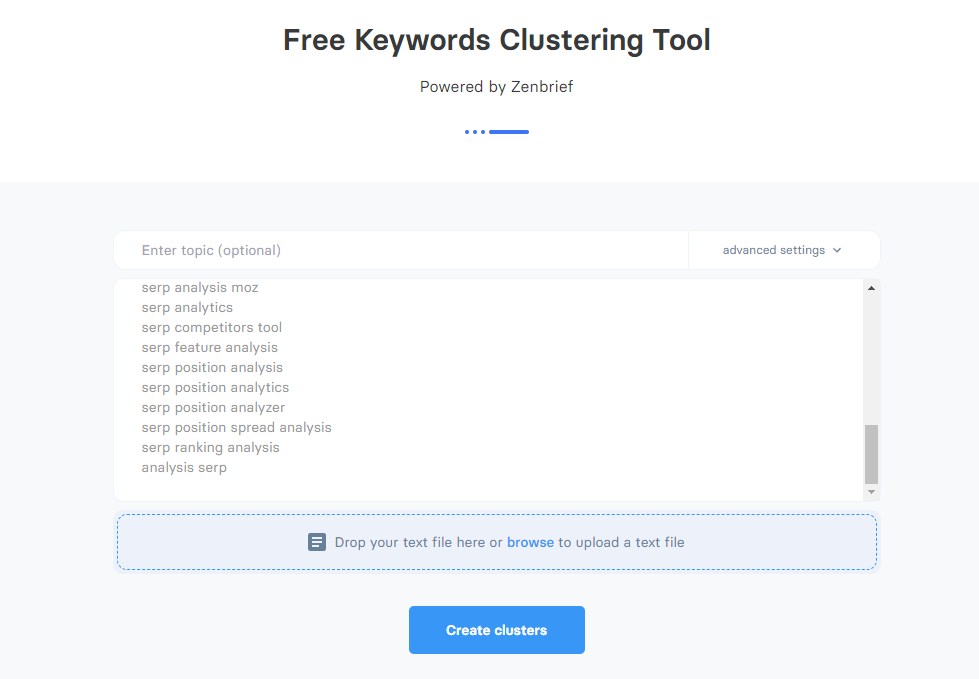
2. SCOHalo SERP Analyzer
You need to download the program from https://www.scohalo.com/serp-analyzer/
This tool can help you to manage millions of keywords and clustering them with words or with SERP.


In this chapter, we will discuss the core idea of enhancing grouping accuracy through automated grouping algorithms that utilize search engine results page (SERP) data. This method aims to improve the accuracy of keyword clustering by considering the actual URLs that appear in search results, rather than just the keyword text itself.
Understanding Automated Grouping Algorithms
Automated grouping algorithms that utilize search engine results page (SERP) data are valuable tools in SEO. These algorithms analyze SERP data to improve keyword optimization, ensuring that the content aligns with user intent and search engine criteria. Embracing these algorithms allows SEO practitioners to deliver valuable information to their audience, fulfilling the core objective of SEO.
Our focus is primarily on improving Google search result rankings through SEO. Accordingly, we accurately determine keyword relevance by analyzing the SERPs of various keywords on Google.
Common Tools for clustering with SERP on the market:
| Product Name | Features | Platform | Price per keyword |
|---|---|---|---|
| SCOHalo SERP Analysis | User-friendly interface/ upload keyword list without creating an account/ rapid keyword grouping/ export cluster list as CSV filehttps://www.scohalo.com/serp-analyzer/ | Windows Program | Free |
| Keyword Insights | AI-powered keyword generation/ clustering based on shared URLs/ customizable clustering settings/ SERP Explorer/ SERP Similarity/ Keyword Discovery/ Content Briefshttps://www.keywordinsights.ai/ | Online | Basic=$58/month/ Professional=$145/month/ Premium=$299/month |
| Semrush Keyword Clustering | Automated keyword clustering/ clustering from scratch or existing keyword list/ competitor keyword clustering/ essential metrics for each keyword cluster/ high ranking potential metric | Online | Start from $79/month |
| SE Ranking’s Keyword Grouper | Utilizes SERP data/ flexible keyword grouping accuracy/ hard or soft analysis/ manual entry or CSV file upload/ refine clusters by country/ location/ and language/ detailed cluster information/ highlighted keywords for content optimization | Online | Keyword Grouper=$0.004 per query/ Search Volume Check=$0.005 per query |
| Surfer SEO’s Keyword Research Tool | Keyword and topic cluster generation/ no need to upload keyword list/ user-friendly cluster visualization/ filter results based on search intent/ search volume/ and keyword range/ streamlined content creation process | Online | Basic=$89/month/ Premium=$299/month |
| ClusterAi | Semantic keyword clustering based on shared search intent and semantic relationships/ agglomerative algorithm for enhanced accuracy/ utilizes SERP analysis/ clean and intuitive user interface/ customizable target country audience | Online | Hobbyist=$39/month for 10 keywords/ Consultant=$89/month for 50 keywords/ Team=$179/month for 150 keywords/ Team+=$249/month for 250 keywords/ Agency=$389/month for 500 keywords/ Enterprise+=$699/month for 1000 keywords |
In the next chapter, we will discuss different methods for choosing the most accurate level of grouping accuracy for your specific needs.
- Improves accuracy of keyword clustering
- Assists with website structure development
- Enhances content creation and paid campaigns
Cons:
- Requires manual review and regrouping
- May result in a large number of ungrouped keywords
Step 1: Begin with a robust keyword foundation by using tools like Google Keyword Planner, ensuring that you have a diverse and extensive list that encompasses various themes and search intentions relevant to your website.
Step 2: Import your keywords into the SCOHalo SERP Analyzer. The platform is adept at managing extensive lists, providing a starting point for strategic keyword clustering.
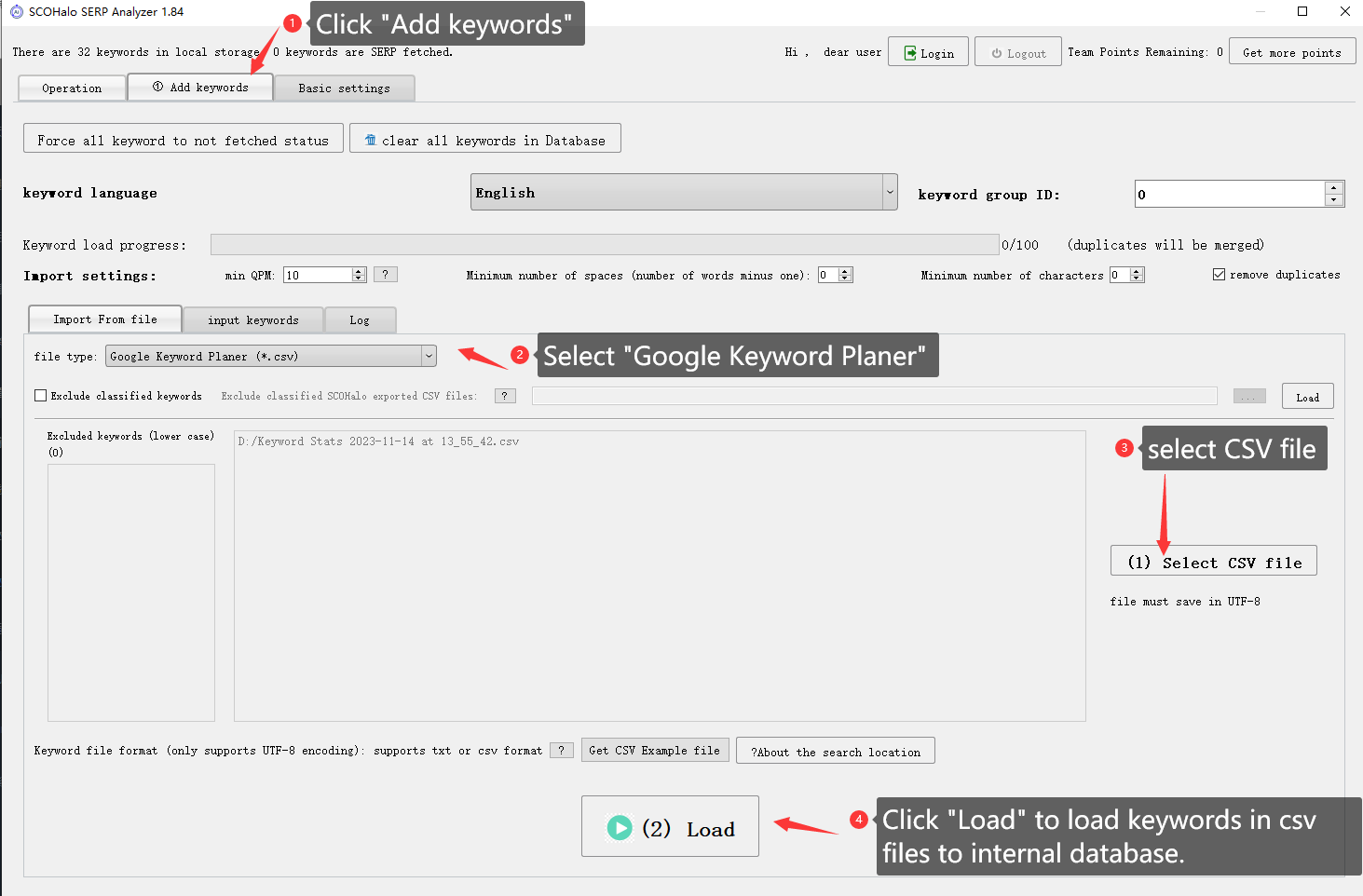
SCOHalo SERP Analyzer provides many parameters to Control the import operations:

Exclude keywords with low QPM, control word/character count, and exclude processed keywords.
Step 3: Start crawling keywords SERP
Click “start crawling SERP” to collect keyword SERP
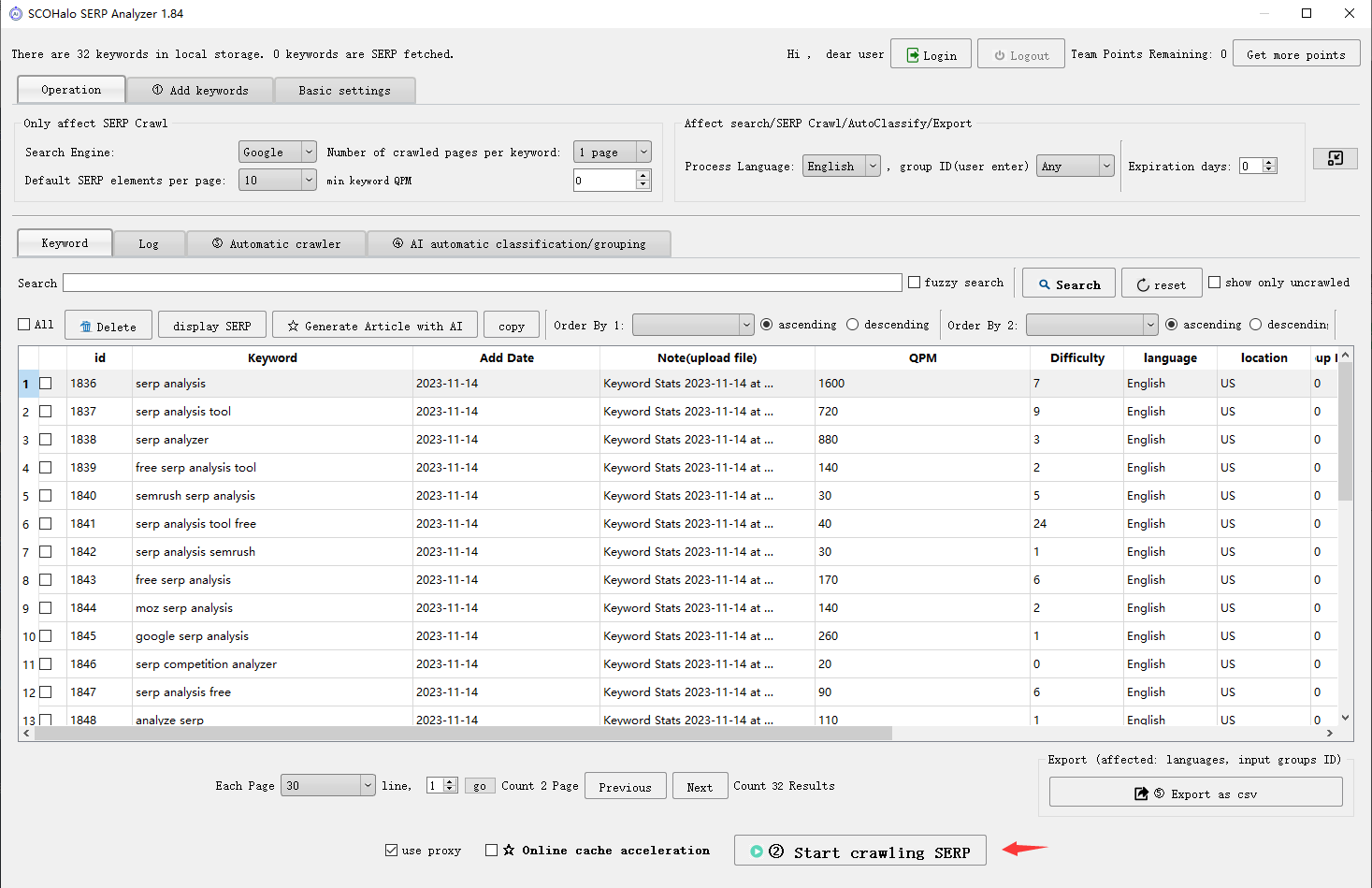
This process may take a long time, please wait patiently.
Step 4: Use “AI automatic classification” to clustering keywords with the SERP
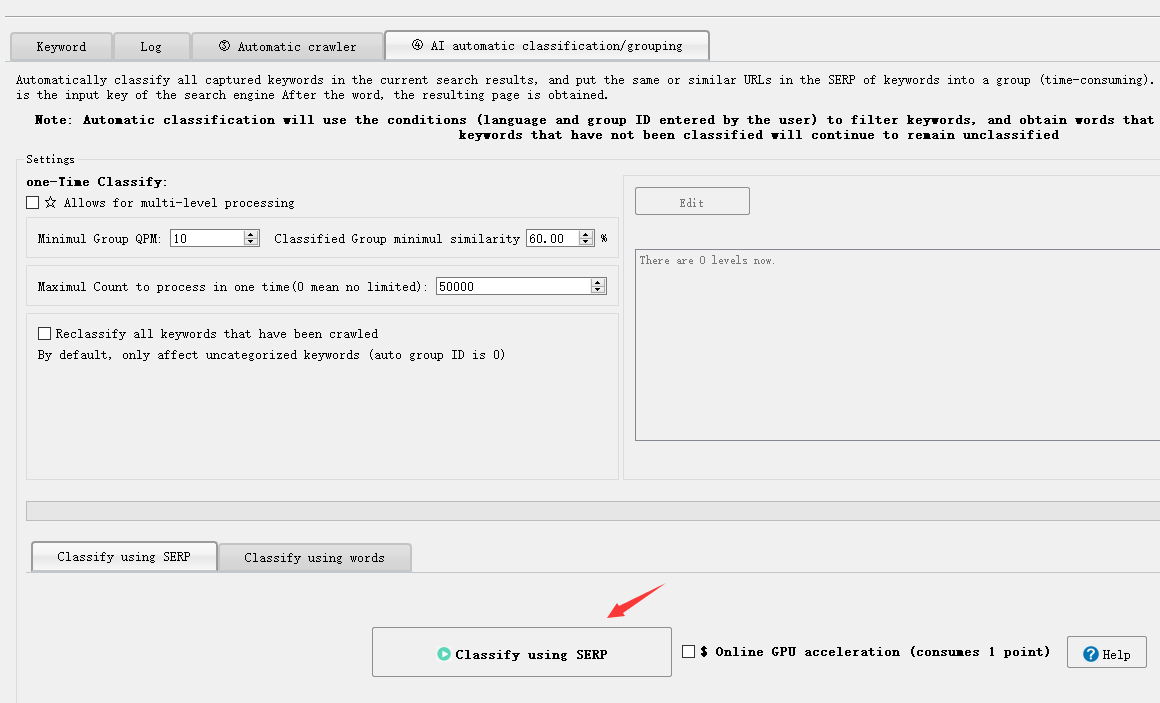
The most important parameter in this dialog is “Classified Group minimul similarity“, Usually we will set it at 40% to 60% for better results.
After the clustering, you can preview the result in the result dialog.
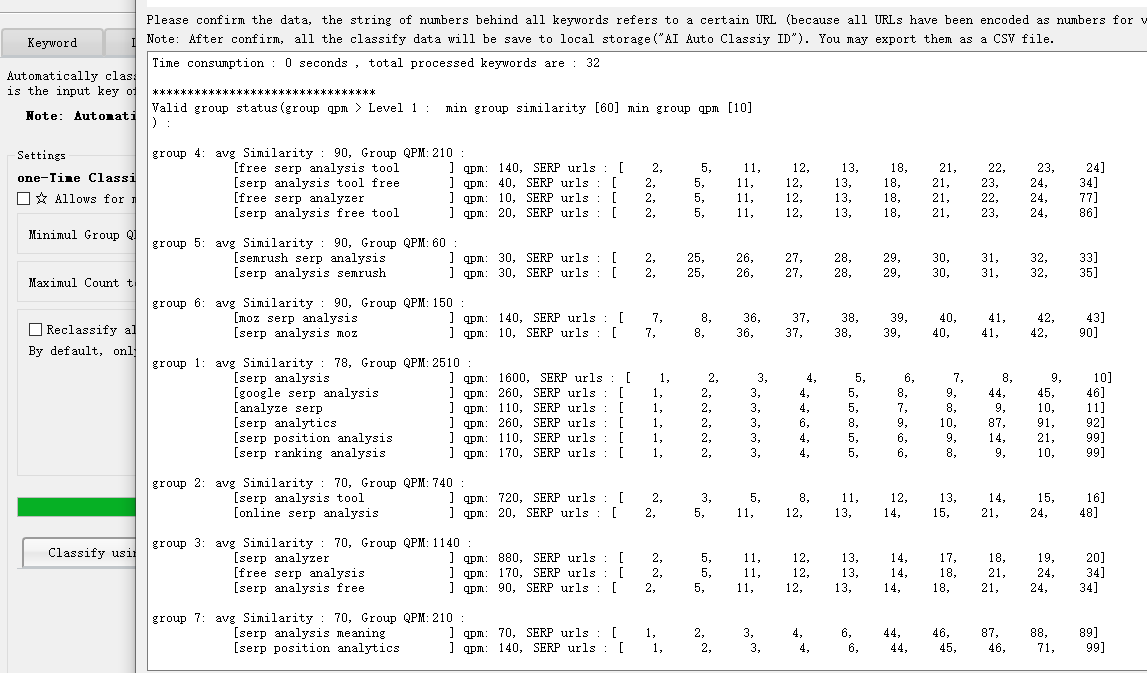
Step 5: click “export as csv” to export clustering result to a csv file
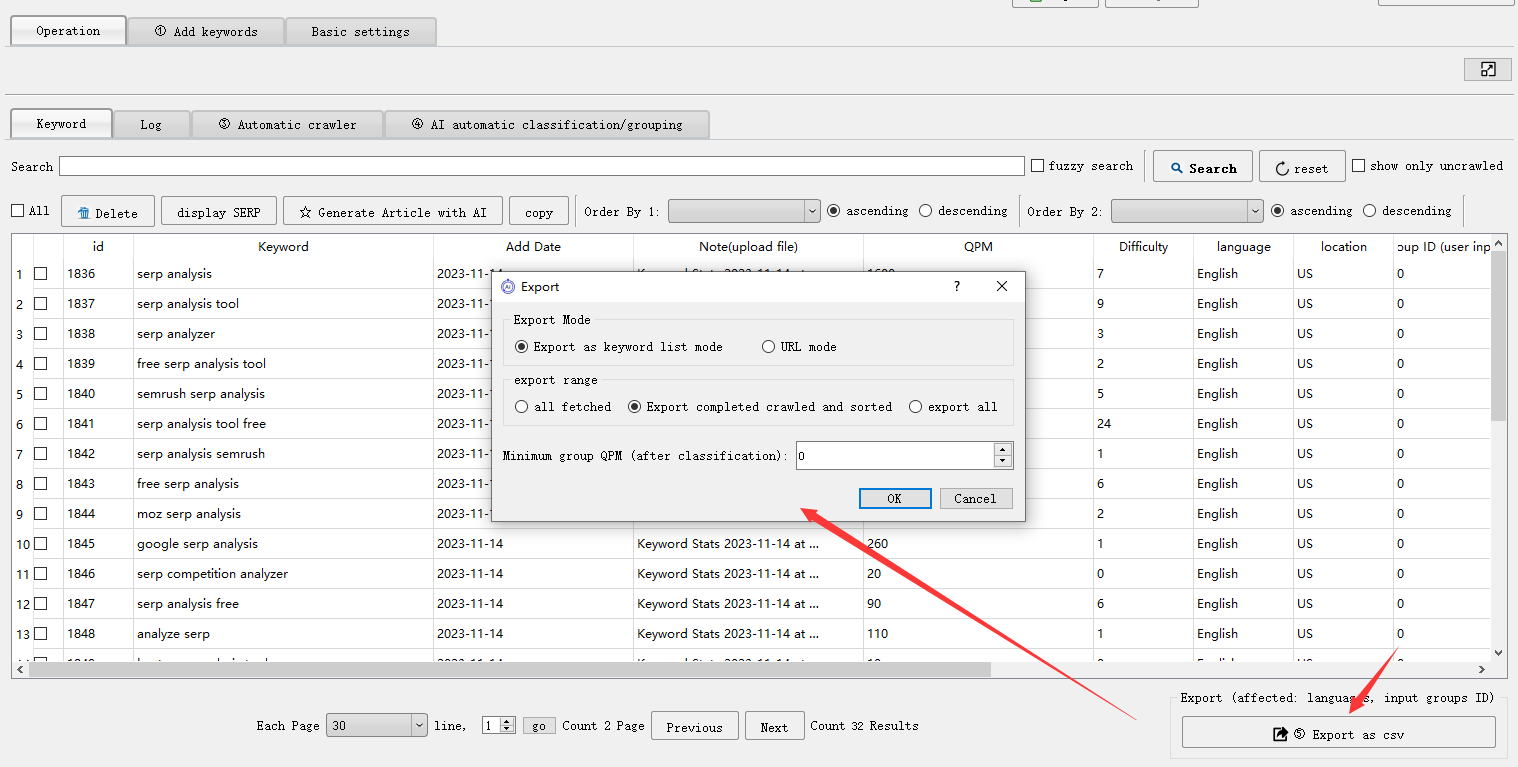
Exported result (all the keywords in the same group will be listed together, you may see the column “AI_ClassifiedID”)
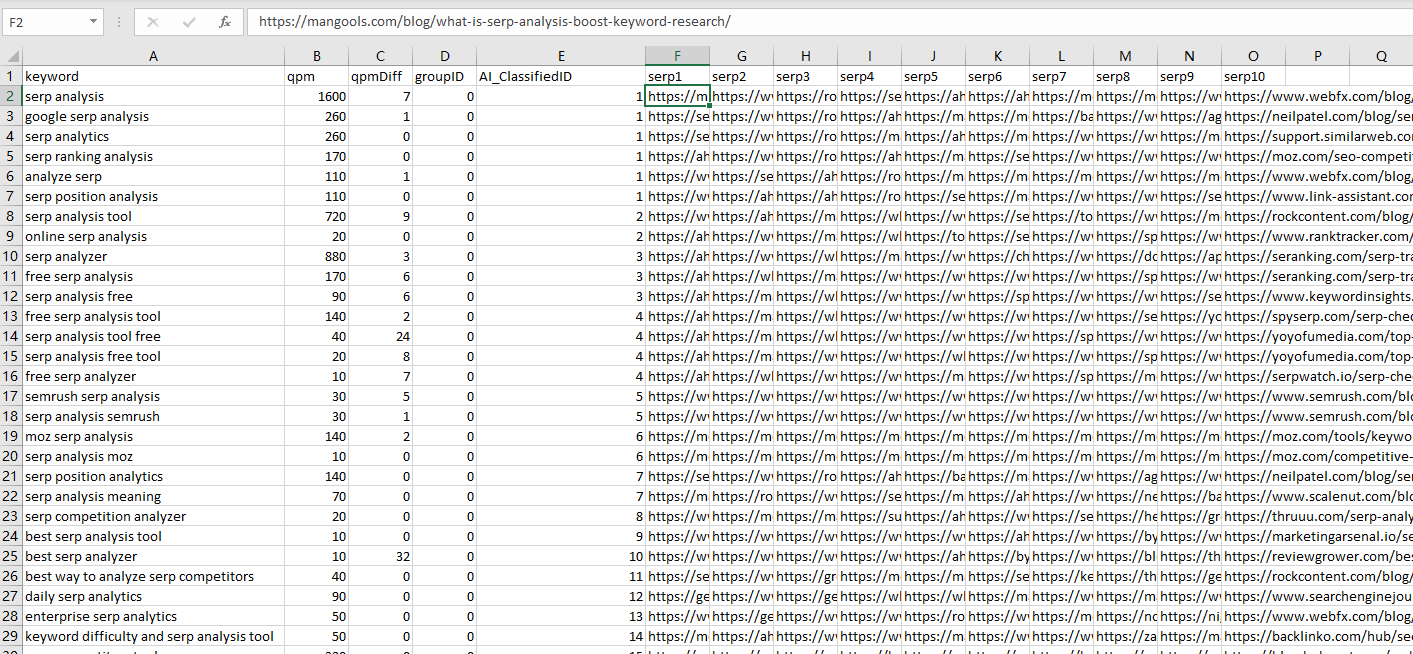
Efficient use of SCOHalo SERP Analyzer within the provided framework allows for the creation of sophisticated keyword clusters that are aligned with user search intent and topic relevancy. The process not only optimizes SEO efforts but also simplifies content management and strategy development. Despite these advantages, SEO experts must recognize that keyword clustering is dynamic. Constant vigilance in reviewing cluster performance and flexibility in adapting to new search patterns are crucial to achieve and sustain top-ranking positions and to maximize online visibility.
In the previous chapter, we explored the use of keywords for clustering and creating tailored articles. Now, let’s delve into writing articles based on these keyword clusters.
Creating content based on keyword clusters is about building a strategic framework that boosts SEO performance and provides an engaging user experience. Once keywords are clustered, SEO professionals can develop pillar pages, serving as comprehensive guides for related keywords within a cluster. While crafting these pages, the similarity threshold for clustering should be considered carefully, generally ranging from 30% to 60%. This range ensures that content is broad enough to cover various user intents and specific enough to establish thematic authority.
A pillar page is a substantial overview on a topic, typically linking to more detailed articles on the website—bridging comprehensive insight and in-depth coverage. Imagine a pillar page as the entry point to an encyclopedia on a specific topic, ranging from 5,000 to 10,000 words, and a launchpad to more specialized content.
Step 1: Identify your central theme, which will form the subject of your pillar page. This should be a balance between a broad topical overview and the potential to delve deeper into related subtopics, aligning with user needs and search behaviors.
Step 2: Gather keywords with semantic similarities between 30% and 60%, using advanced keyword clustering tools such as SCOHalo SERP Analyzer. This software not only supports NLP and SERP analysis for clustering but also allows customization of clustering settings to suit your SEO strategy, whether it’s for a local business or a global enterprise.
Step 3: Stratify your keywords into subtopics that collectively represent a cluster aligned with the main theme of the pillar page. Ensure these clusters reflect different facets of user intent within the overarching topic.
Step 4: Develop cluster content pages, which are intricately detailed pages focusing on specific queries or keywords from each subtopic. These should link back to your main pillar page, establishing a clear relationship and a navigational structure.
Step 5: Populate your pillar page with extensive content that organically integrates the clustered keywords. Aim to become the definitive source on the topic, driving the user journey from broad explorations to the specifics of each cluster.
Incorporating keyword clusters into the content architecture promotes thematic concentration and content depth. This methodology not only captures a wide array of related search intents but also signals to search algorithms like Google’s RankBrain the site’s topical expertise. By creating a primary pillar page linked closely with cluster content, a website becomes an authority on the subject, thus improving its SEO ranking.
- Enhanced SEO through clear structure and topic relevance
- Superior user experience via streamlined content discovery
- Recognition as an authority in the specific field
Cons:
- Content redundancy if keyword similarity is not balanced
- Regular audits and updates of internal links required to avoid outdated or broken paths
In the previous chapter, we used SCOHalo SERP Analyzer to cluster keywords from Google SERP, forming Keyword Groups. Now, we’ll explore how to efficiently store these groups and utilize the SCOHalo Platform’s AI capabilities for more accurate article writing based on the analysis results.
Step 1: Upload the csv files containing the clustered keywords to SCOHalo.
SCOHalo support creating keyword groups by uploading csv files.
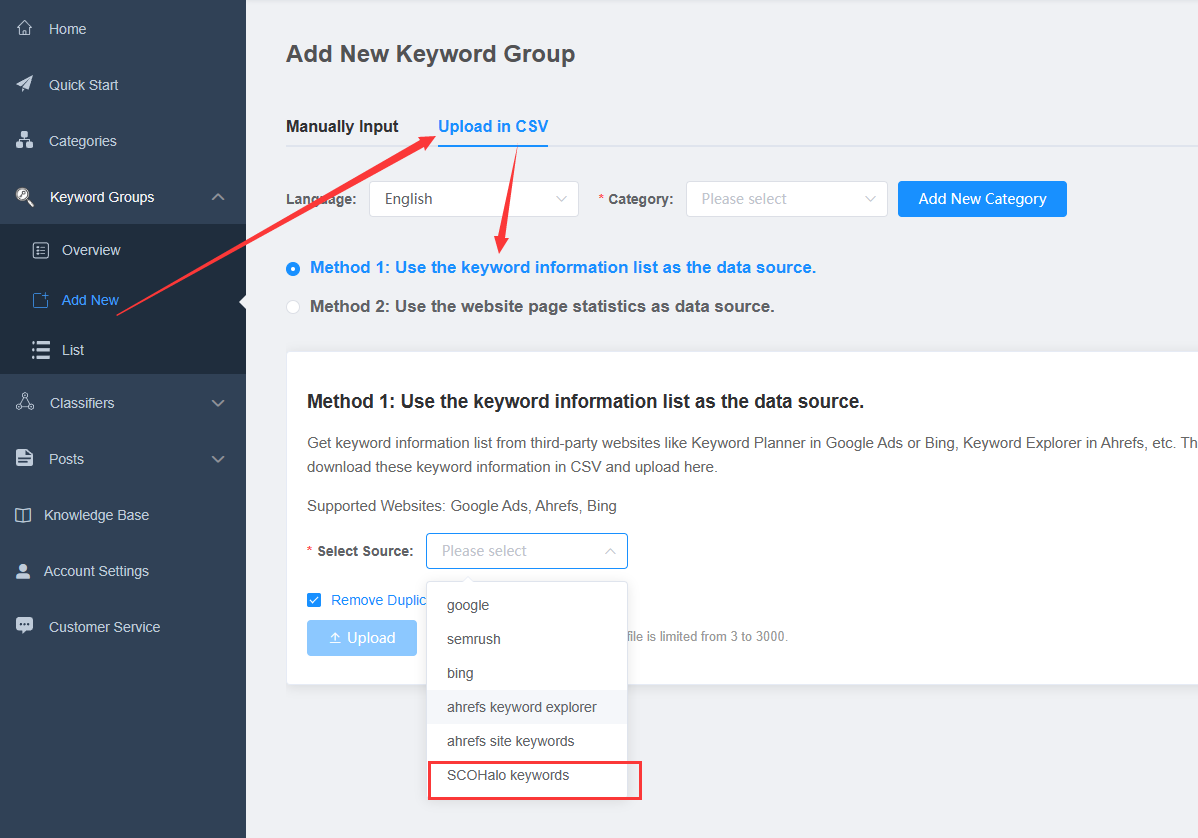
Since the keywords has been seperated into groups, SCOHalo will create the keyword groups in a short time.
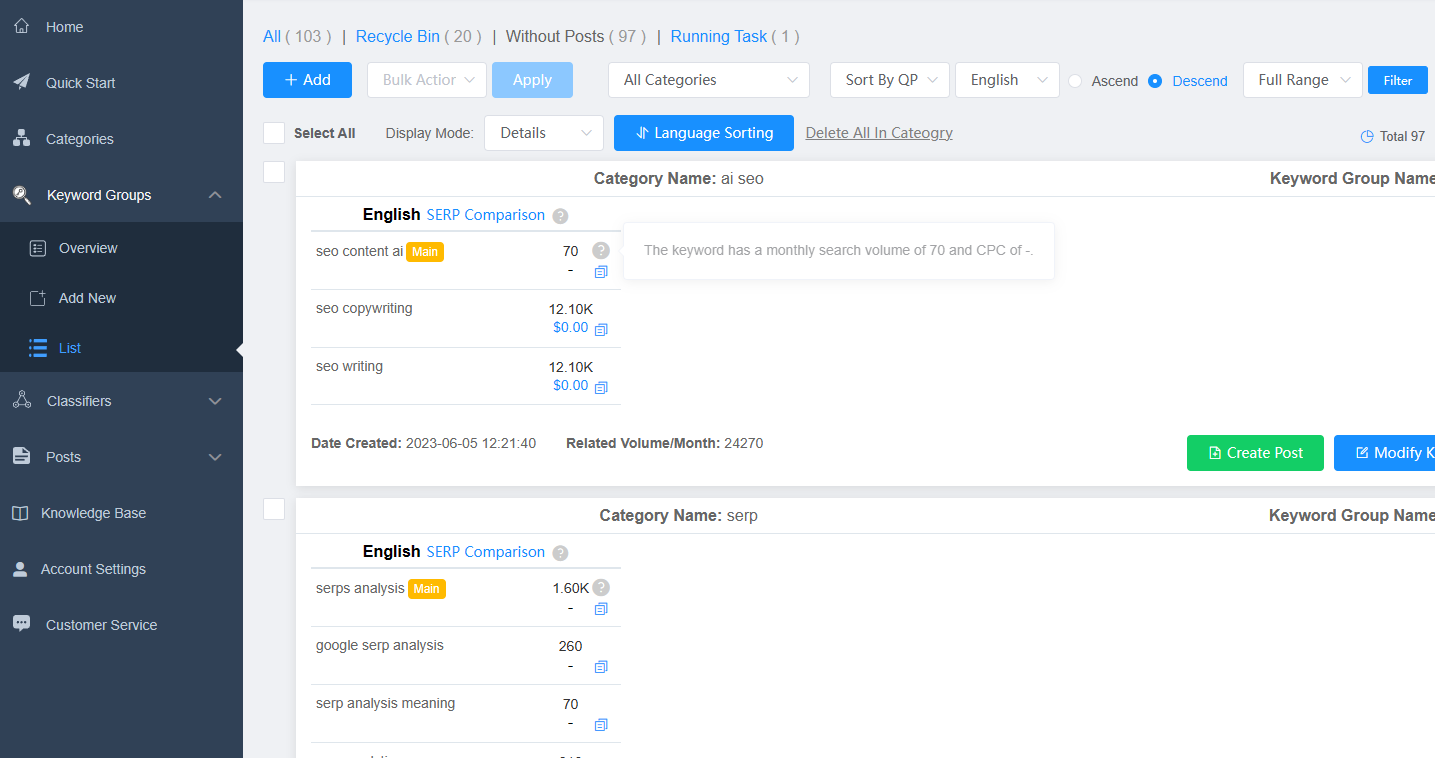
Step 2: Once the keyword groups are created, you can click the “Create Post” button on each keyword group to obtain a snapshot of its thematic scope and use AI to create a draft with these

Within SCOHalo, select a keyword group to analyze its theme and create a SEO-optimized draft.
Implementing SCOHalo for keyword clustering and content outline generation bridges the gap between data-driven SEO and creative content writing. This chapter guides SEO experts through a seamless process of converting keyword clusters into ready-to-use content plans. The outcome is a draft that stands on the solid foundation of strategic keyword groupings and is primed for further development into informative, high-quality articles.
In summary, this approach combines the analytical strengths of SCOHalo SERP Analyzer with the content planning capabilities of SCOHalo, fostering a workflow that is both efficient and fine-tuned to SEO best practices. Users should be mindful of the balance between AI-generated suggestions and human creativity to ensure content authenticity and relevance. Additionally, analysts should consider the cost of tools and their integration within broader SEO platforms to ensure a cost-effective and synergistic digital marketing strategy.
Analyzing keyword performance over time is a key element for SEO experts who employ sophisticated keyword clustering strategies. By tracking both absolute and relative rankings, experts can gain a comprehensive understanding of a website’s position for key terms in comparison to competitors. This necessitates a balanced focus on both long-tail and short-tail keywords to capture diverse user intent and search behaviors.
Step 1: Implement a robust keyword tracking system using reliable SEO tools such as Google Analytics, Google Search Console, SEMrush, Ahrefs, or Moz. These platforms can deliver accurate data regarding your website’s ranking for a gamut of keywords and provide valuable insights into competitive performance.
Step 2: Establish a regular schedule for monitoring keyword rankings, with a frequency that balances being informative and manageable—this can range from weekly to more frequent checks, depending on your needs and the dynamics of your industry.
Step 3: Examine both the short-tail and long-tail keyword performance to evaluate various aspects of user search behavior and to understand how each contributes to overall site visibility and traffic.
Step 4: Utilize these insights to refine your SEO strategies. Identify successful tactics that correlate with positive rank changes and determine areas that require optimization or content enhancement.
Step 5: Incorporate competitor rank tracking into your strategy using tools that offer this feature. By understanding the keyword performance of your competitors, you can exploit gaps in their strategies and fortify your position in the SERPs.
While Google Analytics and Google Search Console offer great starting points for keyword rank tracking, premium tools such as SEMrush and Ahrefs can expand your capabilities with advanced features for tracking, benchmarking, and gaining deeper insights.
By diligently tracking and analyzing keyword rankings and adapting your SEO strategies accordingly, you create a responsive and agile approach to SEO. This practice enables you to decipher patterns, preemptively address potential issues, and target opportunities for growth. The focus should remain on strategic long-term outcomes rather than transient rank fluctuations, ensuring sustainable success in search engine rankings.
In summary, effective post-launch keyword tracking is characterized by the use of accurate tools, a structured monitoring schedule, an analysis of both absolute and relative rankings, and the ability to adapt strategies based on actionable insights. While the process can be time-consuming, the insights gained are invaluable for maintaining and improving a website’s SEO performance. When tracking and monitoring keyword rankings, SEO experts should be mindful of data accuracy, the different behaviors indicated by various keyword types, and the competitive landscape. Ultimately, the goal is to leverage tracking data not only to understand the current standing but also to forecast changes and to innovate continuously in response to an ever-evolving digital ecosystem.
- Comprehensive understanding of website's position for key termsAbility to identify successful tactics for optimizationExploiting gaps in competitors' strategies
Cons:
- Time-consuming processPotential data accuracy issuesTransient rank fluctuations
In the previous chapter, we discussed how to analyze the performance of keywords over time after launching a website. While this is important for understanding the overall success of your SEO strategy, it’s also crucial to track keyword rankings in order to make necessary adjustments and improvements. This chapter will focus on how to track keyword rankings post-launch and use that information to optimize your website for better search engine performance and user experience.
Step 1: Identify your target keywords and clusters
The first step in tracking keyword rankings post-launch is to identify the keywords that are most important for your website. These are the keywords that are relevant to your content and reflect the search intent of your target audience. Use tools like Google Keyword Planner or SEMrush to research and determine your target keywords.
Once you have identified your target keywords, group them into clusters based on their search intent. This will help you avoid keyword cannibalization, where different pages on your website compete for the same keywords and end up bringing down each other’s rankings.
Step 2: Monitor keyword rankings
There are various tools available for tracking keyword rankings, such as Ahrefs, Moz, and Serpstat. These tools allow you to input your target keywords and track their rankings on different search engines over time. They also provide additional metrics, such as search volume and competition, to help you analyze your keywords” performance.
Monitor your keyword rankings periodically, such as weekly or monthly, to see how they change over time. This will give you insights into how well your SEO strategy is working and if any adjustments need to be made.
Step 3: Analyze keyword performance and make adjustments
Based on your keyword ranking data, analyze the performance of your keywords and clusters. Look for patterns and trends, such as certain keywords consistently ranking higher or lower, and use this information to make necessary adjustments to your website.
You may need to optimize your content and on-page elements to better target your keywords and improve their rankings. You may also need to adjust your website’s architecture and internal linking to avoid keyword cannibalization and boost the authority of your top-performing pages.
Step 4: Monitor and review regularly
SEO is an ongoing process, and it’s crucial to continue monitoring and reviewing your keyword rankings post-launch. Keep track of any changes you make and their impact on your keyword performance. This will help you make informed decisions about future optimizations and improvements.
Summary: Tracking keyword rankings post-launch is essential for optimizing your website for both search engines and users. By identifying your target keywords and clusters, monitoring keyword rankings, analyzing performance, and making necessary adjustments, you can improve your website’s visibility and drive more relevant traffic to your content.
Advantages: Tracking keyword rankings post-launch allows you to make data-driven decisions and continuously improve your SEO strategy. By monitoring keyword performance over time, you can pinpoint areas of improvement and focus your efforts on optimizing your target keywords and clusters.
Disadvantages: Tracking keyword rankings can be a time-consuming process, and it requires regular monitoring and analysis. It’s also important to keep in mind that there are various factors that can affect keyword rankings, such as changes in search algorithms and competitor activities, which may be outside of your control.
In conclusion, keyword clustering is a crucial aspect of SEO that can greatly benefit any expert in the field. Through advanced techniques such as utilizing Google Keyword Planner, exploring long-tail keywords, and analyzing search trends, SEO experts can expand their keyword collection and improve their content creation strategies. Manual grouping strategies and automated grouping algorithms with SERP results are both effective ways to enhance grouping accuracy. By choosing the most accurate method, SEO experts can ensure that their content is optimized for maximum visibility. Additionally, developing pillar pages and optimizing blog content based on keyword clusters, as well as integrating cluster insights into content strategy, can greatly improve SEO performance. Finally, tracking keyword rankings post-launch and making adjustments based on rankings is crucial for continued success. By implementing these techniques and strategies, SEO experts can stay ahead of the game and achieve higher rankings on search engines.

